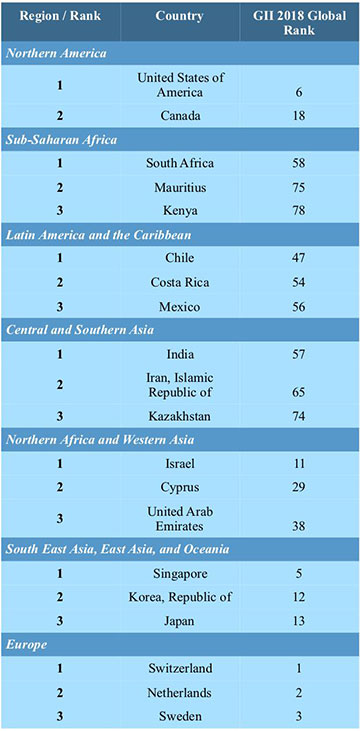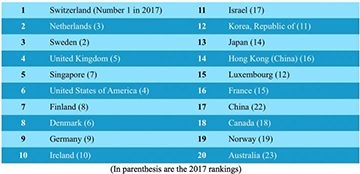The top 20 economies on the 2018 Global Innovation Index. [Image: GII 2018] [Enlarge image]
LLast week saw the publication of the 11th annual Global Innovation Index (GII)—a ranking of 126 global economies according to their relative friendliness to innovation. One interesting high-level takeaway: according to the metrics used to compile the list, China has captured a place in the top 20 economies, in terms of innovation capabilities and results, for the first time since the index has been compiled.
Gauging innovation climate
The GII is jointly compiled each year by Cornell University, the global business school INSEAD, and the World Intellectual Property Organization (WIPO). It ranks economies based on a series of 80 indicators ostensibly tied to a country’s innovation climate, ranging from patent and IP filings to educational spending to scientific/technical publications to smartphone app creation.
The indicators are organized under five “input pillars” (institutions, human capital and research, infrastructure, market sophistication, and business sophistication) and two “output pillars” (knowledge and technology outputs and creative outputs). The overall GII ranking is a simple average of the weighted indexes of these inputs and outputs. The list’s compilers also calculate an intriguing “efficiency ratio”—the output index divided by the input index.
China and Israel move ahead

Leading innovation economies in specific regions, according to the 2018 Global Innovation Index. [Image: GII 2018]
In addition to moving from a rank of 25 on the list in 2016 and 22 in 2017 to 17th place in 2018, China ranked third in efficiency of innovation—a remarkable showing for so large an economy. (The number-one economy in terms of efficiency ratio is Luxembourg; the U.S. economy ranked 22nd in innovation efficiency in the 2018 list.) The country ranked fifth in its region (South Asia, East Asia and Oceania) on the 2018 GII, behind Singapore, South Korea, Japan and Hong Kong.
The study also cites China for substantial improvements in a number of key metrics, including R&D expenditures and the number of researchers, patents and publications. “China presents an impressive example for other middle-income countries to follow as they seek to join the echelons of high-income economies,” according to the report.
In addition to China, another big mover on the GII has been Israel, which has climbed from 21st on the list in 2016 to 11th in the 2018 study. Interestingly, Israel’s rank in terms of innovation efficiency has also grown over the same period, from 23rd in 2016 to 14th in 2018.
Switzerland, which has topped the GII for some time, again led in 2018. The other countries in the top 10 included The Netherlands, Sweden, the United Kingdom, Singapore, the United States, Finland, Denmark, Germany and Ireland. While the United States ranks sixth on the 2018 list, it remains, according to the report’s compilers, the biggest contributor in some key innovation inputs and outputs, including R&D investment.
Identifying “innovation achievers”
The GII also slices and dices its data in other interesting ways. One of the report’s regular features is a list of “innovation achievers”—economies that perform at least 10 percent better in innovation metrics than their peers at the same GDP levels. This year, the list included 20 countries—three more than the previous year’s roster, according to the report, with six of the countries from sub-Saharan Africa.
An unusually rich resource, the 2018 GII also features a focus on green technologies and climate-friendly energy, with a series of narrative chapters that drill down to energy innovation in a variety of country and regional settings. The document highlights the need in particular for technological development across the entire energy value chain—an emphasis that obviously resonates with some photonic R&D sectors such as photovoltaic technology.
The 2018 GII and the reports from previous years are downloadable at www.globalinnovationindex.org.

